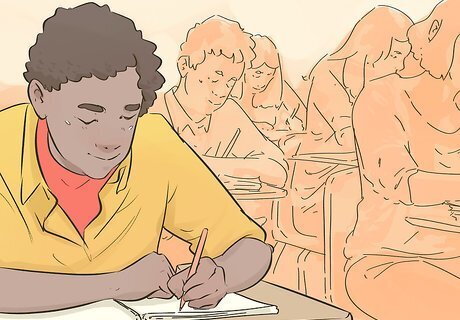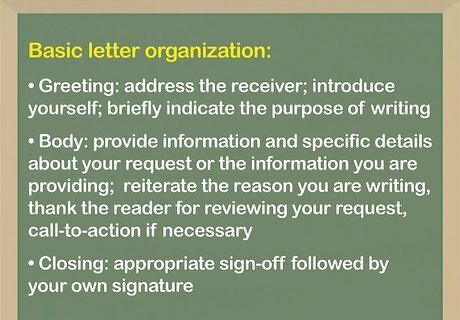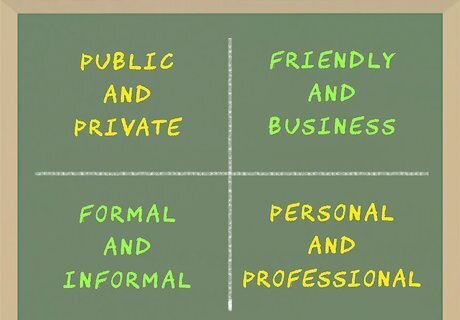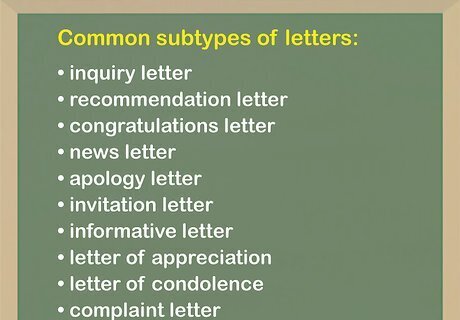
views
X
Trustworthy Source
Reading Rockets
Online resource supported by PBS providing research-based strategies for assisting children to become confident readers
Go to source
While teaching letter writing can seem like a challenging task, by evaluating your students' skills, teaching them the basic foundational elements, and providing opportunities for practice, you can help your students successfully master the art of letter writing.
Evaluating Your Students' Skills

Assign an initial letter writing exercise. To help you asses your students' skills and abilities, conduct an easy writing exercise. Take note of the tone and structure of their writing in the exercise, as well as the spelling and grammar, so that you can identify what your students will need to work on. You can assign this initial writing exercise in person on the first day, or, if you want to assess your students' skill levels ahead of time, you can send out an assignment to be returned to you via email before your lessons begin. The type of exercise you create for your assessment may vary depending on your students ages. If you are teaching letter writing to children, for example, you may want to design a simple exercise like asking your students to write a brief thank you note, or write about an activity they enjoy.

Look over some of your students' previous writing. Ask your students to share a few examples of their previous writing, preferably letters they have written in the past. Take note of the tone, structure, spelling, and grammar of their writing so that you can identify what your students will need to work on. You can ask them to send you a digital copy via email, or ask them to bring a hard copy on the first day. If your students are sending you a copy of their previous writing via email, ask if it is possible for them to send you a scanned copy of handwritten writing so that you can assess whether they need to work on their handwriting.

Find out why they are learning letter writing. Ask your students what they want to learn to help you create lesson plans that are right for you specific students. Whether they want to learn basic organization, grammar, and punctuation or a specific type or style of letter writing, it is important that you understand their goals before you begin so that you can create a plan to help them achieve those goals. You might also want to ask your students how they feel about their letter writing skills. Some students may have experience letter writing, but want to learn more to build confidence in their abilities. This will help you know what areas of letter writing to focus on to help your students feel more confident in their ability to write letters effectively.
Teaching the Basics of Letter Writing

Explain why letter writing is important. Regardless of your students' starting point, begin by establishing why letter writing is important to reinforce how the knowledge and skills they will learn will be helpful. Letter writing is an essential skill that most people will need to use at some point in their lives. Explain some of the various contexts in which they will need to write letters, and why writing a letter is effective in those contexts. If you are teaching letter writing to elementary-age students, explain, for example, how a written letter can be emotionally impactful in personal communications. For adult students, you may want to emphasize how a well-written formal letter can give them a competitive edge in their career, or that a handwritten letter of complaint may be more effective in creating change.

Describe basic letter organization. Explain to your students that while the tone, subjects, and grammar may vary depending on the type of letter, basic letter organization is generally the same. Letters of all types are comprised of three parts: a greeting, a body containing the letter's message, and a closing. In the greeting, explain that your students should address the person receiving the letter, say hello, and/or introduce themselves. Letter writers may also choose to briefly indicate the purpose of the letter in their greeting. The body contains the message of the letter, which expands on the purpose of the letter. The body is generally the longest part of a letter and can contain one or several paragraphs. In the closing of the letter, students should learn to say goodbye with an appropriate sign-off, such as “Sincerely,” “Best,” or a simple “Thank you,” all followed by their own signature. A closing may also indicate the letter writer's preferred type of response.

Introduce the different types of letter writing. Explain the different types of letters, including public and private, formal and informal, friendly and business, personal and professional. Describe to your students how the tone, subjects, and even grammar can vary from one type to another. For example, explain to your students that for a formal letter, they should use simple language that is easy to read and interpret. Explain that for an informal letter, on the other hand, the language they use can be more casual and the letter can be more emotional in tone.

Explain some of the common subtypes of letters. Teach your students about some of the different subtypes of letters, such as letters of inquiry, recommendation, congratulations, news, apology, invitation, providing information, appreciation, condolence, and complaint. Explain that each of the subtypes of letters belong to broader general types and should be written accordingly. It is important that you teach your students to identify the different types and subtypes of letters so they can learn to use the appropriate tone, subject matter, and grammar for each. For example, while using slang and a humorous tone may be appropriate for an informal letter of congratulations, such writing tactics are likely not appropriate for a formal letter of congratulations, such as a college acceptance letter.
Helping with Letter Writing Practice

Guide students through the letter writing process. Before assigning activities for your students to do on their own, guide your students through the letter writing process by collaborating on letters together, or by creating exercises you can do with them. This will help you ensure that your students have mastered the basics of letter writing before proceeding on their own. If you have a board available, try writing a short letter on the board. First, ask your students to read the letter and identify the type and subtype. Ask your students to identify the tone, subject matter, and grammatical choices contained in the letter and get them to assess if each choice is appropriate for the type and subtype. To ensure that they understand basic letter organization, ask one or more students to circle and label the greeting, body, and closing of the letter. If you meet with multiple students at a time, you can get creative with your guided practice by asking each student to add one part or sentence to a letter until the letter is complete.

Provide activities for individual letter writing practice. Assign a timed or reoccurring daily or weekly letter writing activity, and/or provide writing prompts to encourage your students to practice letter writing on their own. Letter writing is a skill that takes time and practice to master, so it is important that you provide ways that your students can improve over time. For some fun, creative letter writing prompts, try asking your students to practice by writing letters to a character in a book, a famous historical figure, or to their future self. Try getting your students to write one letter a week for practice. You can assign a different type of letter each week for more comprehensive letter writing practice. If your students are looking to learn about a specific type of letter writing, you can assign different subtypes of that particular type. For example, if your students want to improve their formal letter writing skills, assign a formal letter of regret for one assignment, and a formal letter of inquiry for another.

Asses your students' letter writing skills. To make the most of their writing practice, provide continuous feedback on your students' letter writing activities. Providing concrete feedback on their writing will help your students see exactly what they are doing well and what they need to improve on. Your students will then be able to make the necessary adjustments as they continue to practice with the activities you have assigned. The type of feedback you provide may vary depending on your students' letter writing goals. In general, it is helpful to provide feedback on handwriting, their use of appropriate tone and subject matters, use of proper organization, and whether their letters contain sound grammar and punctuation. It is also helpful for you to provide feedback on the contents of the letter, assessing whether the letter is clear and whether it conveys what the writer intended.


















Comments
0 comment